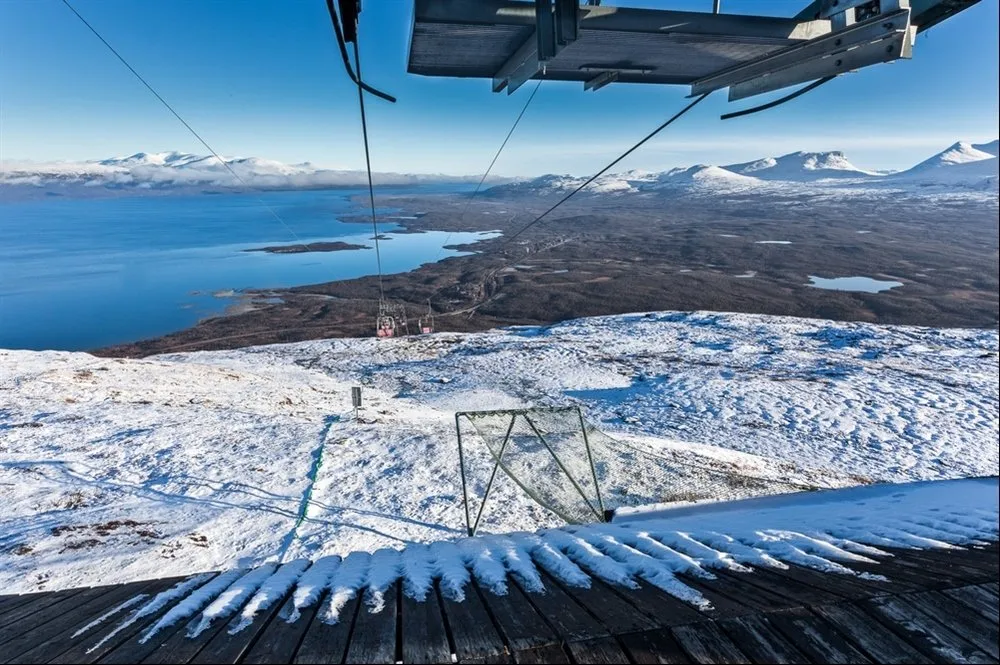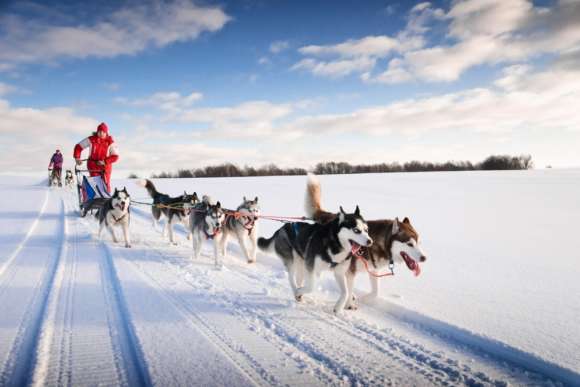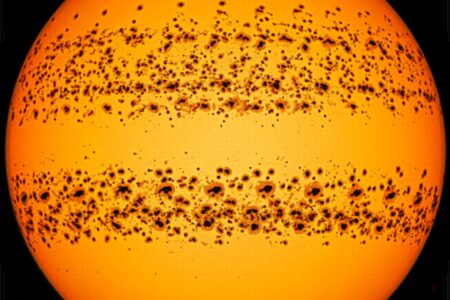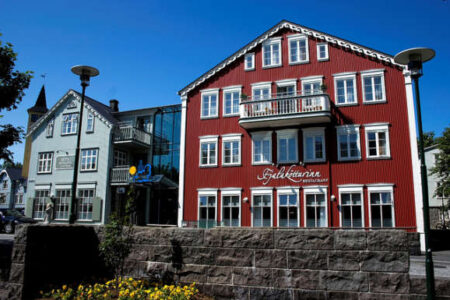Abisko in Sweden is famous for being one of the best places to see the northern lights.
This tiny village, in the very north of Swedish Lapland, is located 150 miles within the Arctic Circle. It sits close to the Norwegian border and a stone’s throw from the craggy mountains and wild landscapes of Abisko National Park.
Visitors come to Abisko for two reasons. In the summer, to hike under the midnight sun. And in the winter? To see the spectacular phenomenon that is the aurora borealis.
So why is Abisko such an amazing northern lights destination? And where should you go to see the northern lights in Abisko? Here’s what you need to know.
Abisko, Sweden: 6 quick facts
Let’s start with a quick Abisko rundown. Get to know this small village in Swedish Lapland with a few essential facts:
- Abisko is known as one of the best places on Earth to see the northern lights.
- Abisko National Park is home to moose, reindeer, lynx, Arctic foxes and golden eagles.
- The village sits on the shores of Torneträsk Lake, which freezes over during winter.
- In Abisko, the sun sets in early December and doesn’t rise again until early January.
- Winter in Abisko is cold! Average temperatures range from -17 to -5 ˚C.
Why see the northern lights in Abisko?
Abisko is known as one of the best places to see the northern lights in Sweden. But why?
First, it’s situated within the Auroral Oval (the place where aurora activity is most likely to occur). It’s also out in the wilderness, far from artificial lights that obscure the aurora from view.
This is true of many great northern lights destinations. So what makes Abisko so special?
Well, you have the best chance of seeing the northern lights when there are no clouds in the sky. And Abisko enjoys a unique microclimate.
The surrounding mountains protect the region from clouds and rain. They create what is known as a “blue hole” over Abisko. And clearer nights means more aurora sightings.
Based on recent seasons, you have a 91% chance of seeing the northern lights on a trip to this area.
Browse northern lights holidays in Abisko
When to visit Abisko
If you want to see the northern lights in Abisko, travel between September and early April. During this time, nights are long and dark, which means more hours to chase the aurora.
The exact time you plan to visit will depend on what you want to do on your trip. Here’s what you can expect:
- Autumn. Abisko National Park is a blaze of golden colour. This is a great time to go hiking, kayaking, wild swimming or foraging.
- Winter. Visit Abisko in winter and you’ll find frozen lakes and rivers, and a landscape blanketed in snow. Perfect for snowmobile and husky-sled adventures.
- Spring. In February and March, Abisko is still snowy and cold. But days are getting longer. That means a wonderful balance of daytime exploration and nighttime aurora hunting.

Accommodation in Abisko
The beauty of Abisko is its remoteness. So there aren’t as many accommodation options here as in other northern lights locations.
That being said, accommodation in Abisko is exceptional. You’ll find modern, stylish Scandi design and a cosy place to relax and warm up after Arctic adventures.
Here are a few of our favourite places to stay in and around Abisko.
Aurora Sky Station
Up on the top of Mount Nuolja, 900 metres above sea level, sits the Aurora Sky Station. Accessed by chairlift, this northern lights viewing spot is also an unforgettable place to stay. There are 104 basic but comfortable rooms, a restaurant with panoramic views and a large outdoor terrace, where you can watch the northern lights dancing across the sky.
Take a look at our favourite Aurora Sky Station tours:
Abisko Mountain Lodge
Abisko Mountain Lodge is a beautiful mountain retreat, tucked away in a quiet corner of Abisko village, with views of the majestic Mount Lappoten. Take your pick from a stylish hotel room or a cosy log cabin. And unwind after a day of adventure in the bar, the sauna or the superb in-house restaurant.
Here are our favourite Abisko aurora tours at Abisko Mountain Lodge:
Self-catering accommodation
Another excellent accommodation option in Abisko village is our two-bedroom self-catering cottage, perfect for couples, friends and families who want an exclusive base from which to explore Swedish Lapland.
The cottage has a high-end interior. Think natural textures, a real log fire and large picture windows that allow you to soak in the beautiful Arctic landscape from the comfort of your own home-from-home.
Our favourite self-catered Abisko aurora tours include the following:
Kåppas Cabin Village
Kåppas Cabin Village is located northwest of Abisko in the small mountain village of Björkliden. Surrounded by peaks and overlooking the pristine Lake Torneträsk, it’s a serene escape for both nature lovers and adventure seekers.
At Kåppas Cabin Village, you can choose from self-catering log cabins with private saunas that sleep up to 6 guests, and comfortable hotel rooms that offer easy access to the resort restaurant.
Here are our favourite Kåppas Cabin Village tours:
Things to do in Abisko
There’s so much to see and do when you travel to see the northern lights in Abisko. Here at Aurora Nights, we create an itinerary based on the activities you’re most excited to try. So you get a northern lights trip to Abisko that is tailor-made for you.
Want some inspiration? Check out these incredible Arctic adventures.
Take the chairlift up to the Aurora Sky Station
Even if you’re not planning to stay there, you can still take the chairlift up to the Aurora Sky Station for an unforgettable experience. Enjoy a gourmet four-course dinner surrounded by panoramic mountain views. Then, head out onto the terrace to stargaze and (hopefully) catch a glimpse of the northern lights.
Embark on a snowmobile adventure
Travel across Abisko National Park at speed on a thrilling snowmobile safari. Glide over frozen rivers and snowy terrain, stopping for warm drinks beside a roaring fire in the wilderness. In this picturesque part of Swedish Lapland, you can discover the frozen expanse of Lake Torneträsk and the unique glacial formation of Lapporten.
Go on a photography tour
Capture the aurora borealis in all its glory with the help of expert photographers. On an aurora photography tour, you venture to prime viewing locations within Abisko National Park. Then — using your own camera or a camera preset for aurora photography — you’ll learn how to take stunning northern lights images, preserving those magical moments for a lifetime.
Ice climbing
Get the adrenaline pumping on an ice climbing adventure in Abisko Canyon, making your way up a frozen waterfall with the Abisko Mountains as your backdrop. There are falls suited to both beginners and experienced climbers, and all the equipment you need (including ice climbing crampons and ice axes) is provided.
Go hiking, snowshoeing and ice fishing
If you want to explore this Arctic wonderland at a slower pace, embark on a guided hike, exploring the flora and fauna of this beautiful region, looking out for reindeer, moose, Arctic foxes and golden eagles. Or why not snowshoe across Lake Torneträsk before learning the art of ice fishing and preparing freshly caught Arctic char over an open fire?
Mush a team of huskies
Move smoothly through the silent, snow-covered landscape on a dog sledding excursion. You’ll get to know the dogs and learn to mush your own team of huskies. Then, travel with your guides through the breathtaking beauty of Abisko National Park.
Take a day trip
The famous Ice Hotel is only a 90-minute drive from Abisko. You can take a day trip and enjoy a cocktail in one of the coldest bars on Earth. Or you can opt to stay the night in an intricately carved Ice Suite. Another exciting day trip idea? Head across the border to Narvik in Norway, where you can take the cable car up Narvikfjellet and enjoy lunch overlooking the fjord.
Hunt the aurora
Of course, no trip to this part of the world would be complete without an Abisko aurora hunt or two. Travelling with an expert aurora guide, you’ll head out after dark to the best northern lights locations. Your guide will read the weather and the aurora forecast, taking you to locations that promise the best and brightest displays.
Browse northern lights holidays in Abisko
Northern lights in Abisko: FAQs
Where is Abisko?
Abisko is located in Swedish Lapland, in the far north of Sweden. It sits on the shores of Torneträsk Lake and close to the Norwegian border. The closest towns are Kiruna in Sweden (90km away) and Narvik in Norway (80km away).
How do you get there?
The closest airport to Abisko is in Kiruna. It’s then just over an hour’s drive from the airport to Abisko.
Most flights from the UK and the USA stop at Stockholm Arlanda Airport. You can then take an internal, 90-minute flight to Kiruna, taking your pick from a choice of flight times each day.
Alternatively, you can take the scenic route, travelling from Stockholm to Abisko by train.
Is Abisko a good place to see the aurora borealis?
Abisko is an exceptional place to see the aurora borealis. Dramatic landscapes. Inky black skies. And a microclimate that gives you excellent odds of seeing the aurora, even over a short 3-day break.
Why book an Abisko holiday with Aurora Nights?
Book a northern lights holiday to Abisko with Aurora Nights and you can count on the following:
- Tailored trips — our travel experts create a bespoke northern lights tour to match your interests, budget and schedule
- Exceptional experiences — we know Abisko inside-out, so you can count on hand-picked accommodation and activities
- Experienced local guides — our guides in Abisko take you off the beaten track to see spectacular scenery and track down the northern lights
- A hassle-free holiday — let us organise your northern lights trip so you can relax and look forward to your Arctic adventure
Whether you want to embark on a short break, a luxury holiday or a family trip to see the northern lights in Abisko, our team can turn your aurora dreams into a reality.
Where else in Sweden is good for the northern lights?
There are lots of other wonderful places to visit on a northern lights holiday to Sweden. These include Kiruna (Sweden’s most northerly city) and Luleå (famed for its spectacular archipelago).
How do I book to see the northern lights in Abisko?
Booking with Aurora Nights is easy. Just follow these simple steps.
- Browse our northern lights tours for inspiration.
- Get in touch with the Aurora Nights team to talk through your holiday wish list — the destinations, accommodation and activities you want to include.
- Let us plan the perfect Arctic itinerary, creating a tailored northern lights experience just for you.
- Relax and look forward to your aurora adventure while we manage trip organisation and logistics.
Have your heart set on Abisko? Take a look at our Abisko aurora holidays to get started.












